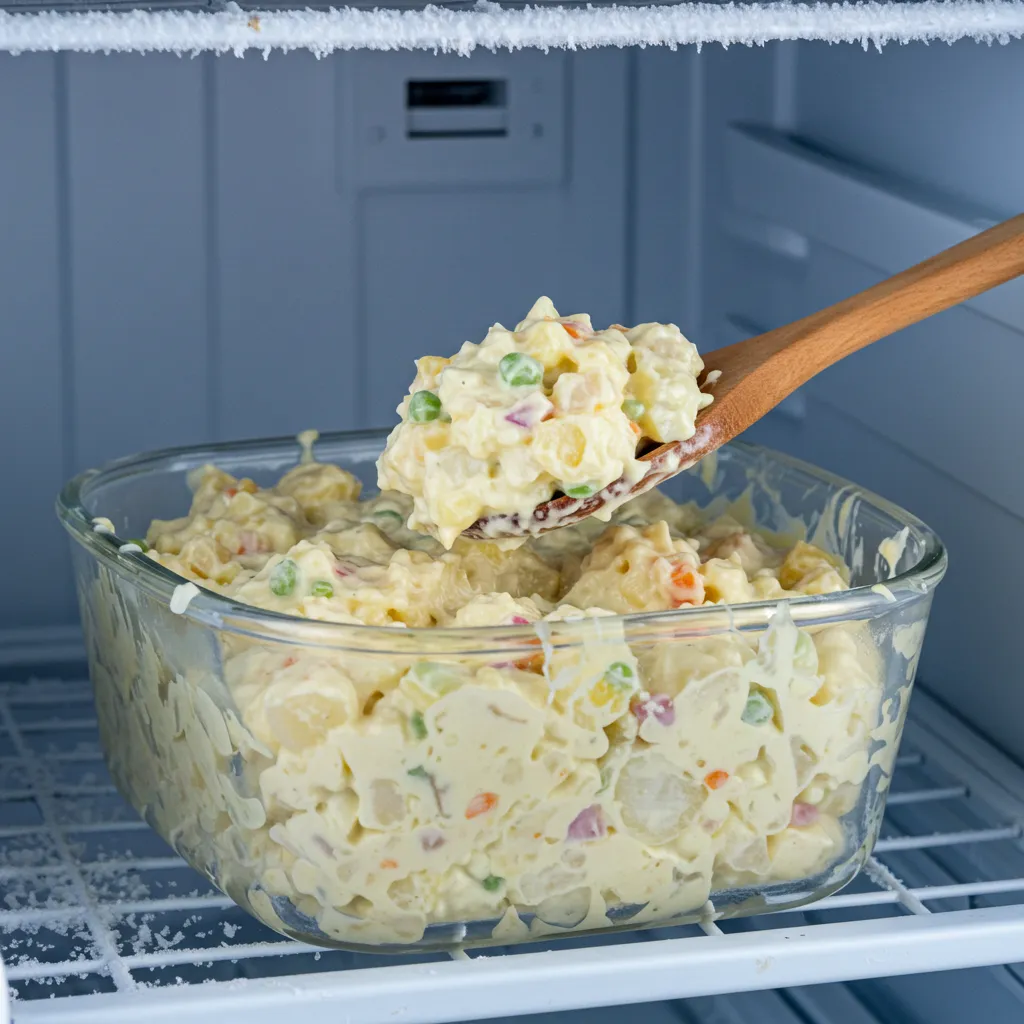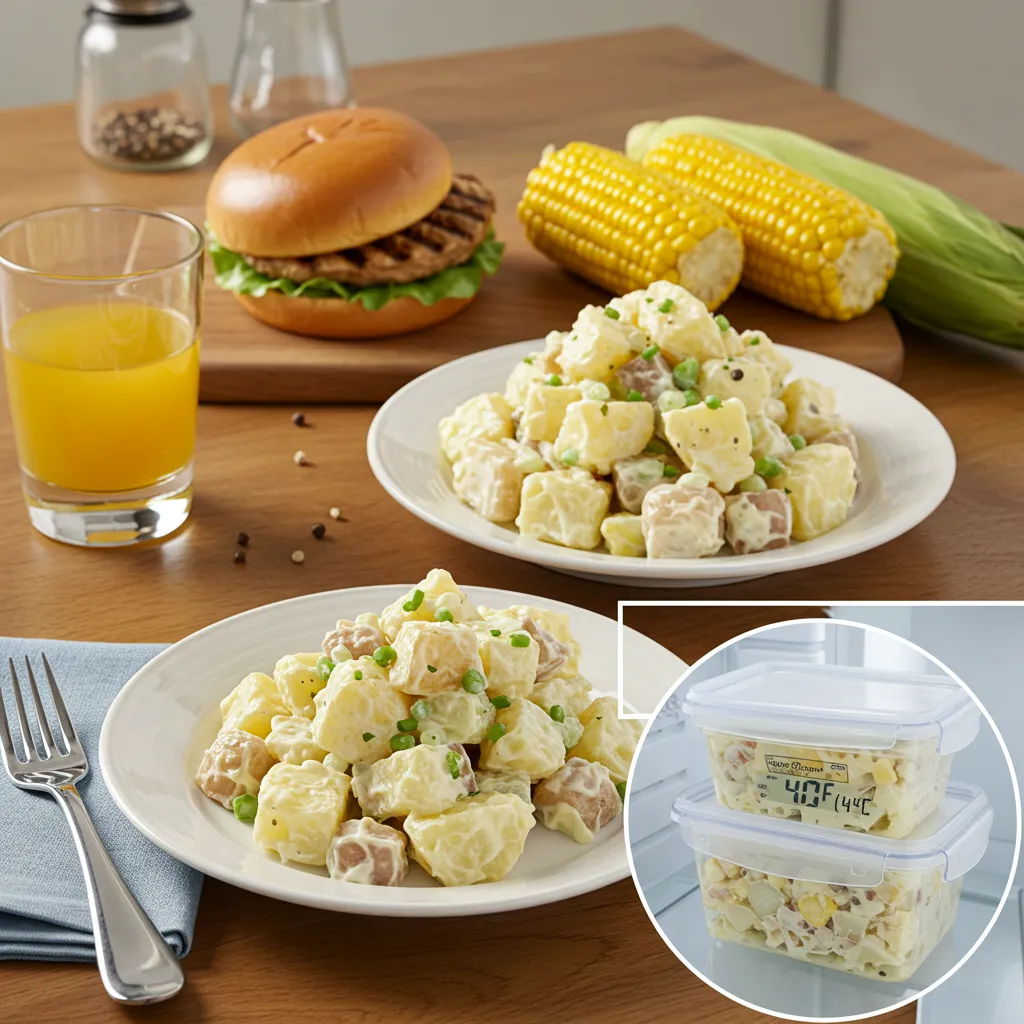Ever found yourself with leftover potato salad and wondered if you could freeze it? It seems like a simple solution to avoid waste, but freezing potato salad isn’t as straightforward as it sounds. While some foods freeze beautifully, potato salad can lose its creamy texture, become watery, or even separate after thawing.
Potato salad is a staple at picnics, BBQs, and family gatherings. Its rich, creamy dressing and tender potatoes make it a favorite side dish. However, when stored improperly, it can turn into a mushy, unappetizing mess. That’s why understanding the right way to store or freeze potato salad is crucial.
In this guide, we’ll break down whether freezing potato salad is a good idea, what happens to its ingredients in the freezer, and the best methods to keep it fresh without ruining its texture. Let’s dive in and avoid the biggest mistake people make when trying to freeze potato salad.
Print
Classic Creamy Potato Salad
- Total Time: 27 minutes
- Yield: 6 servings
- Diet: Vegetarian
Description
This classic creamy potato salad is the perfect side dish for BBQs, picnics, and family gatherings. Made with tender Yukon Gold potatoes, crisp celery, red onion, and a tangy, flavorful dressing, this recipe is rich, creamy, and full of fresh ingredients. It’s easy to customize and even better when made ahead, allowing the flavors to meld together.
Ingredients
For the Salad:
- 2 lbs Yukon Gold potatoes, scrubbed and cut into bite-sized cubes
- 3 hard-boiled eggs, chopped
- ½ cup celery, finely diced
- ¼ cup red onion, finely diced
- ½ cup dill pickles, finely chopped (optional)
- 2 tbsp fresh dill, chopped
For the Dressing:
- ¾ cup mayonnaise (or Greek yogurt for a lighter version)
- 1 tbsp yellow mustard (or Dijon for a milder flavor)
- 1 tbsp apple cider vinegar (or pickle juice for extra tang)
- 1 tsp sugar (optional, for balance)
- ½ tsp salt (adjust to taste)
- ½ tsp black pepper
- ½ tsp paprika (for garnish, optional)
Instructions
Cook the Potatoes
- Place potatoes in a large pot and cover with cold, salted water.
- Bring to a boil over medium-high heat, then reduce to a simmer.
- Cook for 10–12 minutes, or until fork-tender but not mushy.
- Drain and let cool to room temperature.
Prepare the Hard-Boiled Eggs
- Place eggs in a saucepan and cover with water.
- Bring to a boil, then remove from heat and let sit for 10 minutes.
- Transfer eggs to an ice bath, peel, and chop.
Make the Dressing
- In a large mixing bowl, whisk together mayonnaise, mustard, vinegar, sugar, salt, and black pepper until smooth.
Assemble the Salad
- Add cooled potatoes, chopped eggs, celery, red onion, pickles, and fresh dill to the bowl with the dressing.
- Gently fold everything together until well combined.
Chill and Serve
- Cover and refrigerate for at least 1 hour to let the flavors develop.
- Before serving, sprinkle with paprika for color.
Notes
- For a healthier version: Substitute Greek yogurt for part or all of the mayonnaise.
- For extra tang: Use Dijon mustard and add more pickle juice or vinegar.
- Storage: Keep in an airtight container in the fridge for up to 5 days. Do not freeze, as the texture will change.
- Make-ahead tip: This salad tastes even better after chilling for a few hours.
- Prep Time: 15 minutes
- Cook Time: 12 minutes
- Category: Side Dish
- Method: Boiled
- Cuisine: American

Why You’ll Love This Recipe
Potato salad is a crowd-pleaser, whether served at summer cookouts, family gatherings, or holiday dinners. But when it comes to freezing, things get tricky. Before deciding whether to store your leftovers in the freezer, here’s why this dish is so special and what you need to know to keep it fresh.
Key Benefits of This Potato Salad Recipe
- Simple to Prepare – Made with everyday ingredients and quick prep.
- Customizable – Adjust seasonings, add mix-ins, or swap ingredients to suit your taste.
- Naturally Flavorful – Fresh herbs, tangy dressing, and creamy potatoes create a perfect balance.
- Great for Gatherings – Ideal for BBQs, picnics, and potlucks.
- Versatile Storage Options – Learn the best ways to refrigerate or freeze without ruining texture.
Does Freezing Affect Potato Salad?
Freezing changes the texture of potato salad, especially if it contains mayonnaise or dairy-based dressings. Here’s why:
- Mayonnaise Separation – Mayo-based dressings tend to break down when frozen, making the salad watery.
- Potato Texture Changes – Cooked potatoes contain water, which expands when frozen, leading to a mushy consistency. Find out why from the Idaho Potato Commission.
- Dairy-Based Dressings Can Curdle – If your salad has sour cream or yogurt, freezing may cause separation. Read more about dairy freezing guidelines from Dairy Council of California.
How to Keep Potato Salad Fresh Without Freezing
Instead of freezing, proper refrigeration is the best way to preserve potato salad. Here’s how:
- Store in an Airtight Container – Prevents moisture loss and keeps flavors intact.
- Keep It at the Right Temperature – Refrigerate at or below 40°F (4°C) to prevent bacterial growth. Check official food safety guidelines at the FDA.
- Consume Within 3 to 5 Days – For best taste and texture, eat it fresh.
If you still want to freeze potato salad, using the right technique can help. The next section covers step-by-step instructions to minimize texture loss and maintain flavor.
Ingredients for the Best Potato Salad

A great potato salad starts with the right ingredients. Using fresh, high-quality components ensures the best texture and flavor. Below, you’ll find a breakdown of the key ingredients, plus substitutions to accommodate different dietary preferences.
Main Ingredients
- Potatoes (2 lbs.) – Yukon Gold or red potatoes hold their shape well and have a creamy texture. Skip starchy varieties like Russets, as they tend to turn mushy after cooking.
- Hard-Boiled Eggs (3, chopped) – Add richness and a classic texture. Skip if making a vegan version.
- Celery (½ cup, finely chopped) – Provides a fresh, crisp bite.
- Red Onion (¼ cup, finely diced) – Adds mild sharpness and color contrast. Soak in water for a few minutes to reduce bitterness.
- Dill Pickles (½ cup, chopped) – Brings a tangy crunch that enhances the flavor.
For the Dressing
- Mayonnaise (¾ cup) – The creamy base of traditional potato salad. Use avocado mayo for a healthier alternative.
- Yellow Mustard (1 tbsp.) – Adds a subtle tang. Dijon mustard can be used for a milder taste.
- Apple Cider Vinegar (1 tbsp.) – Enhances flavor while balancing the richness of the dressing.
- Sugar (1 tsp.) – Optional, but helps round out the flavors.
- Salt & Black Pepper (to taste) – Adjust for seasoning balance.
- Fresh Dill (2 tbsp., chopped) – Brings a fresh, herby brightness to the dish.
Ingredient Substitutions and Dietary Adaptations
- Dairy-Free/Vegan Alternative – Swap mayonnaise with a plant-based version or use mashed avocado for creaminess.
- Low-Carb/Keto Option – Replace potatoes with cauliflower for a lighter version.
- Extra Protein Boost – Add diced grilled chicken or turkey for a heartier dish.
Choosing the right ingredients ensures your potato salad has the perfect balance of flavors and textures. Next, we’ll cover the step-by-step process to make it.
Step-by-Step Instructions for Perfect Potato Salad

Making potato salad is simple, but following the right steps ensures the best texture and flavor. Here’s a foolproof method to prepare a creamy, flavorful potato salad every time.
1. Cook the Potatoes
- Wash and peel (optional) the potatoes. If leaving the skin on, scrub them thoroughly.
- Cut potatoes into evenly sized chunks to ensure even cooking.
- Skip starchy varieties like Russets, as they tend to turn mushy after cooking.
- Heat over medium-high until boiling, then lower to a simmer. Cook for 10–12 minutes, until the potatoes are fork-tender but still hold their shape.
- Drain immediately and let cool to room temperature. For firmer potatoes, spread them on a baking sheet to cool faster.
2. Prepare the Hard-Boiled Eggs
- Set the eggs in a saucepan and pour in cold water until fully submerged.
- Bring to a boil, then turn off the heat and let them sit for 10 minutes.
- Move the eggs to an ice bath and let them chill for a few minutes to stop the cooking.
- Peel and chop into bite-sized pieces.
3. Make the Dressing
- In a large mixing bowl, combine mayonnaise, mustard, apple cider vinegar, sugar, salt, and black pepper.
- Whisk until smooth and well combined. Adjust seasoning to taste.
4. Assemble the Salad
- Add the cooled potatoes, chopped eggs, celery, red onion, and pickles to the bowl with the dressing.
- Gently fold everything together until evenly coated. Be careful not to overmix to avoid breaking the potatoes.
5. Chill and Serve
- Cover and refrigerate for at least 1 hour before serving. This gives the ingredients time to blend, enhancing the overall flavor.
- Garnish with fresh dill or paprika for added flavor and color.
- Serve chilled as a side dish for BBQs, picnics, or family gatherings.
Following these steps ensures a perfectly creamy, well-balanced potato salad. Next, we’ll cover expert tips and variations to customize it to your taste.
Pro Tips and Variations for the Best Potato Salad

A great potato salad is all about texture, flavor, and balance. Here are some expert tips and creative variations to help you perfect the dish and customize it to your taste.
Pro Tips for a Perfect Potato Salad
- Choose the Right Potatoes – Waxy potatoes like Yukon Gold or red potatoes hold their shape better than starchy varieties like Russets, which can become too soft.
- Don’t Overcook the Potatoes – Cook until just fork-tender to prevent them from turning mushy when mixed with the dressing.
- Cool Potatoes Before Mixing – Adding dressing to hot potatoes can cause separation and a greasy texture. Allow them to cool down to room temperature before using.
- Use a Flavor Booster – A splash of apple cider vinegar or pickle juice while the potatoes are warm enhances the overall taste.
- Chill Before Serving – Refrigerate for at least one hour to let the flavors meld and develop a better texture.
- Season Well – Potatoes absorb a lot of seasoning, so don’t be afraid to adjust salt, pepper, and mustard to taste.
Tasty Variations to Try
- Classic Southern Style – Add sweet pickle relish, extra mustard, and a pinch of paprika for a tangy twist.
- Bacon Ranch Potato Salad – Swap mustard for ranch dressing and mix in crispy bacon crumbles and shredded cheddar.
- Herb-Infused Potato Salad – Add fresh chives, parsley, and tarragon for a lighter, garden-fresh flavor.
- Spicy Kick – Mix in a dash of hot sauce or chopped jalapeños for heat.
- Dairy-Free Option – Use avocado mayo or a dairy-free dressing alternative to keep it plant-based.
- Low-Carb Alternative – Substitute cauliflower for potatoes to create a keto-friendly version.
These tips and variations allow you to customize potato salad based on your preferences while ensuring the best texture and flavor. Next, we’ll explore serving ideas and storage tips to keep it fresh longer.
Serving Suggestions and Storage Tips

Potato salad is a versatile dish that pairs well with a variety of meals. Whether you’re serving it at a summer barbecue or as a side for a cozy family dinner, here’s how to present it beautifully and keep it fresh for longer.
Best Ways to Serve Potato Salad
- As a Classic BBQ Side – Serve chilled alongside grilled meats, burgers, or hot dogs for a refreshing contrast.
- With Sandwiches and Wraps – Pairs well with pulled pork, turkey sandwiches, or veggie wraps for a satisfying meal.
- For Brunch or Potlucks – Add it to a spread with deviled eggs, fresh fruit, and croissants for a well-rounded gathering.
- Garnish for Extra Flavor – Sprinkle with fresh herbs, paprika, or crispy bacon for a pop of color and taste.
How to Store Potato Salad Properly
Keeping potato salad fresh requires proper storage techniques to maintain its texture and flavor.
- Refrigeration – Store in an airtight container and keep it at 40°F (4°C) or below. It stays fresh for up to 3–5 days.
- Avoid Leaving It Out – Potato salad should not sit at room temperature for more than two hours to prevent bacterial growth. If serving outdoors, keep it in a cooler with ice packs.
- Freezing Considerations – While not recommended, you can freeze potato salad without mayonnaise. Use an oil-based or vinegar-based dressing instead. When thawing, stir well to restore texture.
Refreshing Leftover Potato Salad
If your potato salad seems dry after refrigeration, try these quick fixes:
- Stir in a spoonful of mayonnaise or Greek yogurt to bring back creaminess.
- Add a splash of vinegar or pickle juice to brighten the flavors.
- Mix in fresh herbs to enhance the overall taste.
Serving potato salad the right way and storing it properly ensures the best taste and texture every time. Up next, we’ll wrap up with key takeaways and answer common questions to help you perfect this dish.

Conclusion: Why This Potato Salad is a Must-Try
Potato salad is a timeless side dish that brings comfort and flavor to any meal. Whether you’re making it for a backyard barbecue, a picnic, or a casual family dinner, following the right techniques ensures the perfect balance of texture and taste.
Key Takeaways
- Use Yukon Gold or red potatoes to maintain firmness and avoid a mushy texture.
- Let potatoes cool completely before mixing to prevent separation.
- Customize your dressing with mustard, vinegar, or pickle juice for extra tang.
- Refrigerate for at least an hour before serving for the best flavor.
What’s Your Favorite Potato Salad Variation?
Do you have a unique twist on potato salad? Maybe a special ingredient that makes yours stand out? Drop your thoughts in the comments — let’s chat about it!
If you’re looking for other delicious comfort food recipes, check out these:
- Porcupine Soup – A hearty and flavorful soup perfect for chilly days.
- How to Make Mustard at Home – A simple guide to homemade mustard for extra tang in your salad dressings.
- The Ultimate Guide to Truffle Hot Sauce – Elevate your flavors with this luxurious condiment.
- What is Pickle Made Of? – Discover the secrets behind making your own pickles at home.
- Creamy Cucumber Salad – A refreshing side dish that pairs well with potato salad.
For more recipe inspiration, be sure to explore Primed Recipes for tried-and-true favorites. Happy cooking!

FAQs: Answering Your Potato Salad Questions
Potato salad is a simple yet versatile dish, but common questions arise about its preparation, storage, and customization. Here are answers to some frequently asked questions to help you perfect your recipe.
1. Can You Freeze Potato Salad?
Technically, yes, but it’s not recommended. Freezing changes the texture, making the potatoes grainy and causing the mayonnaise-based dressing to separate. If you must freeze it, opt for a vinegar-based dressing instead of mayonnaise.
2. How Long Does Potato Salad Last in the Fridge?
Properly stored in an airtight container, potato salad stays fresh for 3 to 5 days in the refrigerator. Keep it below 40°F (4°C) to maintain food safety.
3. Can You Make Potato Salad Ahead of Time?
Yes, and it’s actually better when made in advance. Making it a day in advance helps the flavors deepen and come together beautifully. Just store it properly and give it a quick stir before serving.
4. What’s the Best Way to Keep Potato Salad from Getting Watery?
- Drain the potatoes well before mixing them with the dressing.
- Let them cool completely to prevent excess moisture from releasing into the salad.
- Avoid overmixing, which can break down the potatoes and release water.
5. Can I Make Potato Salad Without Mayonnaise?
Absolutely! For a lighter version, swap mayo for Greek yogurt, sour cream, or a vinaigrette-based dressing. This creates a tangy, fresh flavor while maintaining creaminess.
6. What Are the Best Add-Ins for Extra Flavor?
Customize your potato salad with:
- Chopped bacon for a smoky crunch.
- Fresh herbs like dill, parsley, or chives for brightness.
- Pickles or capers for a tangy kick.
- Spicy mustard or hot sauce for a bit of heat.
7. Can I Use Any Type of Potato?
While any potato can work, Yukon Gold and red potatoes hold their shape best. Avoid Russet potatoes, as they tend to break down and become too soft.
These tips and answers ensure your potato salad turns out perfect every time. If you have more questions, drop them in the comments, and let’s keep the conversation going!


I love Potato Salad, Thank you for this Job!